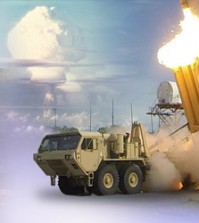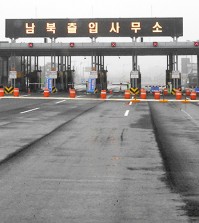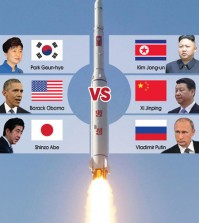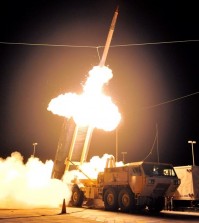- California Assembly OKs highest minimum wage in nation
- S. Korea unveils first graphic cigarette warnings
- US joins with South Korea, Japan in bid to deter North Korea
- LPGA golfer Chun In-gee finally back in action
- S. Korea won’t be top seed in final World Cup qualification round
- US men’s soccer misses 2nd straight Olympics
- US back on track in qualifying with 4-0 win over Guatemala
- High-intensity workout injuries spawn cottage industry
- CDC expands range of Zika mosquitoes into parts of Northeast
- Who knew? ‘The Walking Dead’ is helping families connect
US not ready to discuss THAAD deployment in S. Korea
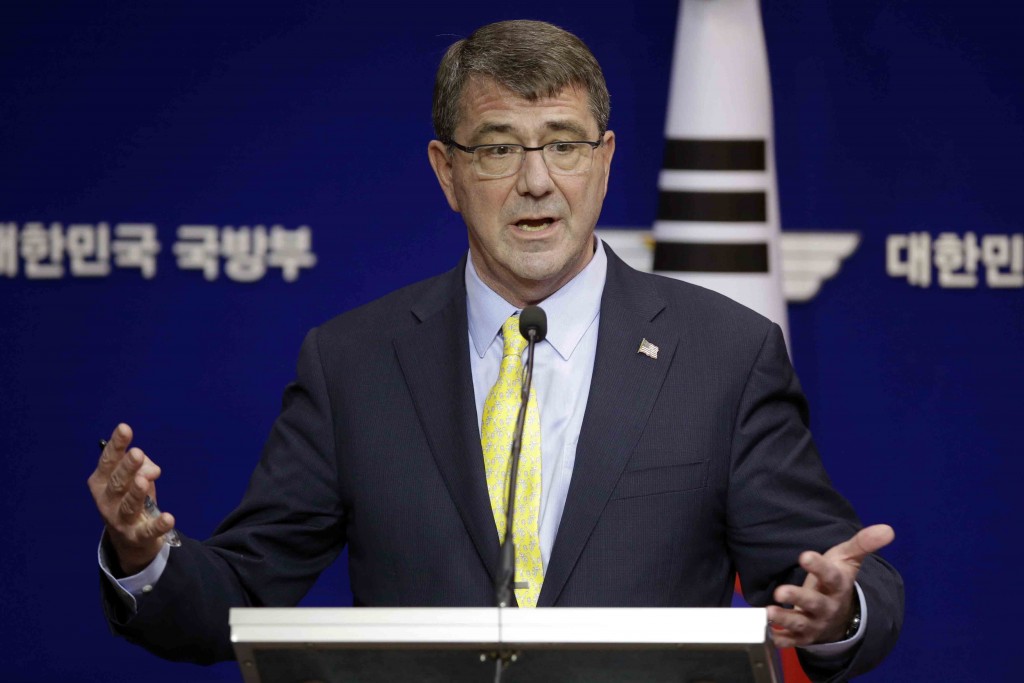
U.S. Defense Secretary Ash Carter answers reporters’ question during a joint news conference with his South Korean counterpart Han Min Koo at the Defense Ministry in Seoul, South Korea, Friday, April 10, 2015. U.S. Defense Secretary Carter said the U.S. has made progress against the Islamic State group in Iraq but cannot predict how long the fight will take. (AP Photo/Lee Jin-man, Pool)
SEOUL, April 10 (Yonhap) — U.S. Defense Secretary Ashton Carter said Friday his country is not ready to begin discussions on the possible deployment of its advanced missile defense system on the Korean Peninsula.
“THAAD was not on the agenda today … This is the program that is in production in the U.S.,” Carter told a joint press conference here with South Korean Defense Minister Han Min-koo.
Citing a series of steps to be taken before the deployment of the Terminal High Altitude Area Defense battery, Carter said, “We are not at a point yet of determining where it might be suitably deployed in the future … We are not a point where we will begin discussions with anyone around the world.”
Whether the U.S. chief will bring up the issue during his first face-to-face meeting with Han has drawn key attention here amid heated controversy at home and abroad with opposition from China and Russia.
Washington has expressed its willingness to deploy the battery here to better protect South Korea and some 28,000 U.S. troops from North Korea’s threats, though officials of the two sides have said no official consultations or decisions have taken place on the matter.
As an integral part of the U.S.-led missile defense system, THAAD is designed to shoot down short, medium and intermediate ballistic missiles at a higher altitude in their terminal phase using a hit-to-kill method.
Carter instead stressed Washington’s plan to deploy its cutting-edge weapons in the Asia-Pacific region.
“Our newest things, best things are being deployed in this part of the world,” he said, citing such examples as new stealth bombers and new classes of naval vessels. “That is the biggest part of our rebalance (to Asia).
Han and Carter said they discussed ways to strengthen joint capabilities and reinforce deterrence in order to effectively respond to North Korea’s provocations and threats during the one-hour talks.
“If history serves as any guide, I think chances are always high for North Korea to be provocative in case it fails to achieve its strategic goals,” Han said, though he added that the allies have not confirmed any imminent signs of Pyongyang’s additional nuclear tests and missile launches.
Stressing that Pyongyang is “intent on continued provocations” by making good on its nuclear and ballistic missile threats, Carter said the U.S. “is committed to stability in the region and the combined defense of the Republic of Korea (South Korea).”
“On the peninsula, the deterrence and readiness are at a premium. So we are investing advanced capabilities to make sure that our top new investments are tailored to this dynamic security environment,” he said, vowing to continue to stage Seoul-Washington joint exercises.
The allies have regularly conducted joint military exercises including Key Resolve, a computerized command post exercise, and the field training exercise Foal Eagle, despite the communist country’s call to stop them, claiming they are “a dress rehearsal for a northward invasion.”
After the press conference, the two chiefs visited the Navy’s 2nd Fleet Command to pay tribute to South Korean sailors who died in the sinking of the country’s warship, Cheonan.
On March 26, 2010, the 1,200-ton naval corvette sank in the Yellow Sea, killing 46. A South Korean-led international investigation found that the North had torpedoed the ship, though Pyongyang has denied responsibility. The hull of the vessel is on display at the fleet’s headquarters in Pyeongtaek, some 70 kilometers south of Seoul.
The Cheonan case is “a solemn reminder of the threat that North Korea poses to our alliance,” Carter said, underlining that the allies stand ready to respond that threat accordingly.
Carter is the first U.S. defense minister to have visited the memorial.
Speaking of the regional history row between South Korea and Japan, Carter said the U.S. “is hopeful for healing and reconciliation.”
“We have a lot of respect for historical legacy issues in this region and we think it’s important,” the top Pentagon official said, while making it clear that the U.S. will not “interpose itself between the parties here.”
He also watered down his call on the U.S., South Korea and Japan to “look forward to the future” as “the potential gains of cooperation … outweigh yesterday’s tension and today’s politics.”
He made the remarks in an interview with Japan’s Yomiuri Shimbun ahead of his Asian trip, which flared up strong opposition from South Koreans who still have painful memories of Japan’s harsh 1910-45 colonial rule.
“In speaking of the future, I was referring to the agreements to share information in the future among the three militaries, which I think has a great promise for the security of all of us,” Carter said, stressing that he “was not referring to the past.”
Late last year, the three countries signed an arrangement to share classified information on North Korea’s missile and nuclear programs, but the long-strained Seoul-Tokyo relations have hampered Washington’s efforts to strengthen trilateral cooperation with its two key Asian allies in the region marked by the rising China and threats from North Korea.
The U.S. defense chief arrived here on Thursday as the second leg of his first trip to the Asia-Pacific region since taking office last month. He flew from Japan after wrapping up a three-day visit there.
The U.S. secretary will leave here on Saturday for the country’s Pacific Command in Hawaii on his way back home.







